Pompeii & Naples -
- GenX
- May 15, 2018
- 2 min read
Updated: May 16, 2018

When Vesuvius erupted on August 24, AD 79, it engulfed the two flourishing Roman towns of Pompeii and Herculaneum, on it’s way, the hot lava swallowed wealthy villas surrounding the region. Since then, the two magnificent towns have been excavated extensively and made accessible to the public from the mid-18th century. Pompeii was a core business thoroughfare and is larger than Herculaneum, thus our decision to explore it.

Mount Vesuvius, a volcano near the Bay of Naples in Italy, is thousands of years old and has erupted more than 50 times. In 1748, explorers discovered the city, they were astounded to find that–underneath a thick layer of dust and debris–Pompeii was mostly intact.



The Greek settled in the area in the 8th century B.C., the region around Mount Vesuvius and the Bay of Naples attracted wealthy vacationers due to it’s proximity to the sea. By the turn of the first century A.D., the town of Pompeii, located about five miles from the mountain, was a prosperous resort for Rome’s most notable citizens. Stylish houses and intricate villas lined the paved streets. Tourists, townspeople and slaves bustled in and out of small factories and artisans’ shops, pubs and cafes, and brothels and bathhouses. People gathered in the 20,000-seat arena and lazed in the open-air squares and marketplaces. On the eve of that fateful eruption in 79 A.D., scholars estimate that there were about 20,000 people living in Pompeii.


Mount Vesuvius has not erupted since 1944, it is one of the most dangerous volcanoes in the world. Scientists believe that another Plinean eruption is due any day--an unfathomable catastrophe, since almost 3 million people currently live within 20 miles of the volcano’s crater.






コメント